The annual Snapshot Cal Coast period is scheduled to coincide with the best midsummer low tides, to maximize opportunities for people to get out and blitz the intertidal. The whole idea of Snapshot Cal Coast is to document as much biodiversity as possible, to render a comprehensive account of what our coastal and nearshore biota look like at this moment in time. For someone like me, participating in the various bioblitzes that occur during Snapshot is a good excuse to get up early and play in some of my favorite intertidal sites.
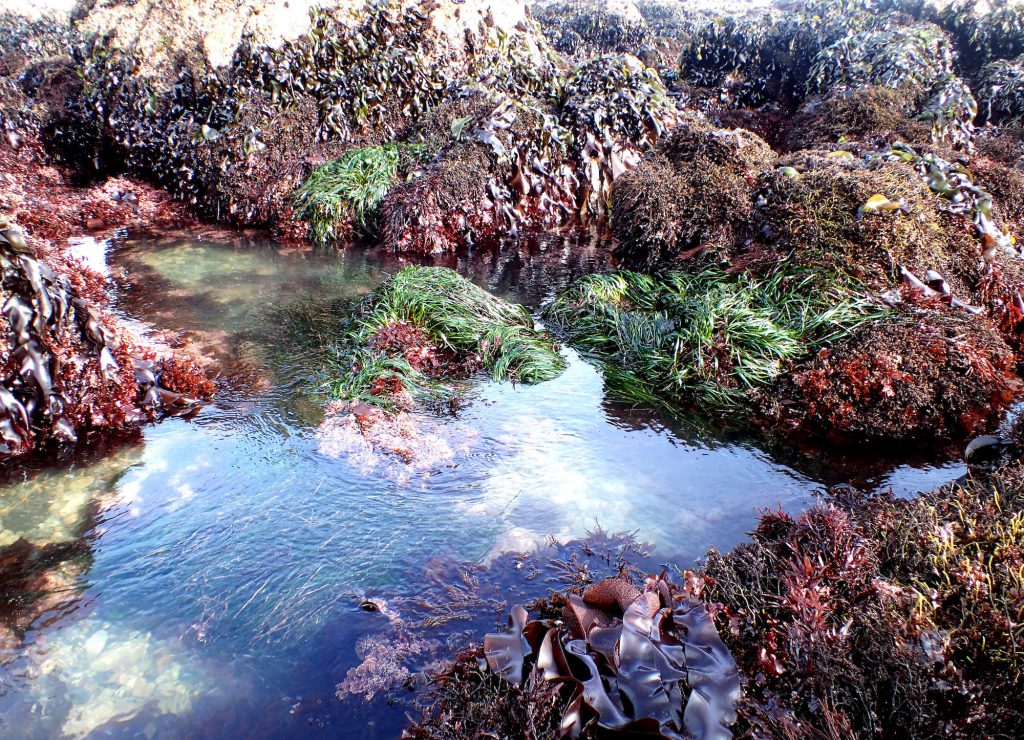
07 June 2019
© Allison J. Gong
We’re in the high summer growing season now, and the algae are taking off. Pigeon Point has always been a great spot for seaweed diversity, and I anticipated having a lot much phycological fun when I went there last week. And, very happily, I was not disappointed. There were many animal finds as well, including some nudibranchs that I brought back to the Seymour Center, but the algae were definitely the stars of the show. So I thought I’d show off how beautiful and diverse they are.
The red algae
The vast majority of macroalgae at Pigeon Point are red algae, in the phylum Rhodophyta. Everywhere you look is a sea of rosy pinks, dark purples, and bright or brownish reds, punctuated now and then by a brilliant splash of green which is due to the surfgrass (not an alga!), Phyllospadix. The algae cover all surfaces. They drape into and drift with the water currents. They provide shelter and food for the animals of the intertidal. They make walking a treacherous undertaking–a large part of exploring the intertidal safely is knowing which algae will support your weight and which will dump you on your butt without a moment’s hesitation.
At first look, the eye is bombarded with a confounding mélange of reds, dark greens, pinks, and purples. Knowing that they are all in the Rhodophyta doesn’t help you make sense of what you are seeing. As usual, what helps is an ability to flip between what I call ‘forest’ and ‘tree’ observing: you can spend some time zeroing in on individual specimens and learning or remembering their names, but every once in a while you need to step back and take note of the larger environment where and with whom these species live.
Here’s a small forest view to study. How many different red algae can you see?
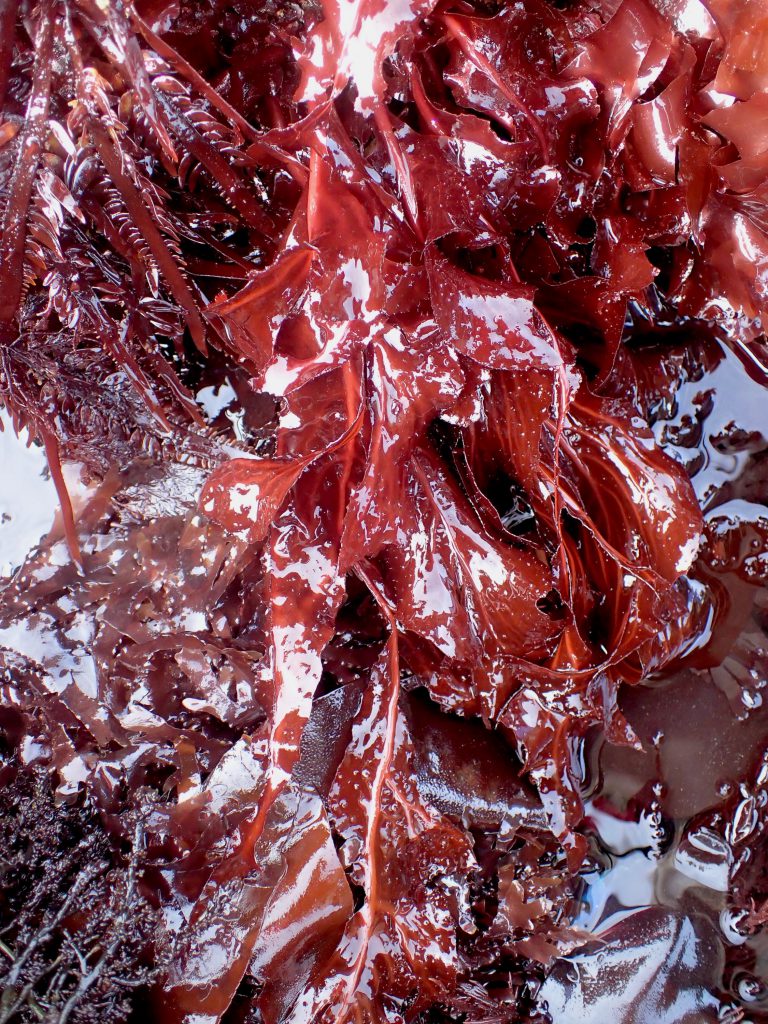
07 June 2019
© Allison J. Gong
It’s kind of a trick question. A knowledgeable person can probably pick out seven or eight different species. I can distinguish six but can identify only five with any real certainty.
Here’s the same photo, with some of the algae labeled for identification:

- Species A: Prionitis lanceolata
- Species B: Erythrophyllum delesserioides (my favorite alga!)
- Species C: either Cryptopleura or Callophyllis
- Species D: Neogastroclonium subarticulatum
- Species E: Mazzaella splendens
Just because it’s my favorite, and is undeniably beautiful, here’s another photo of Erythrophyllum:
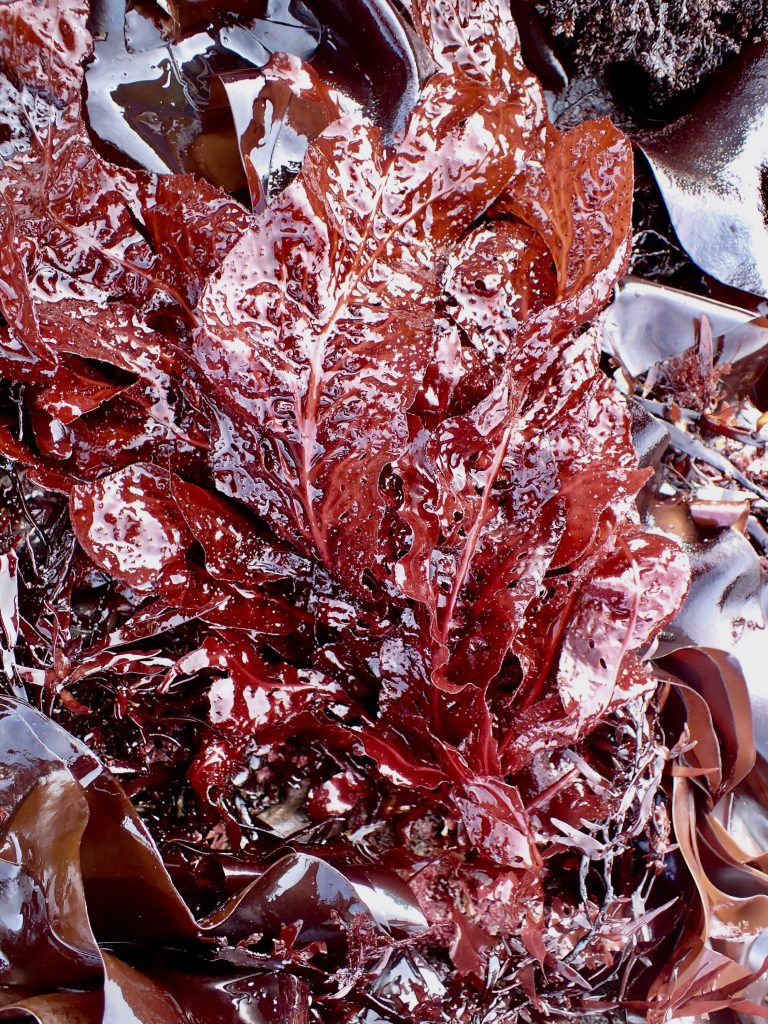
07 June 2019
© Allison J. Gong
To give you some idea of the color and morphological variety in the reds, here’s a quartet:
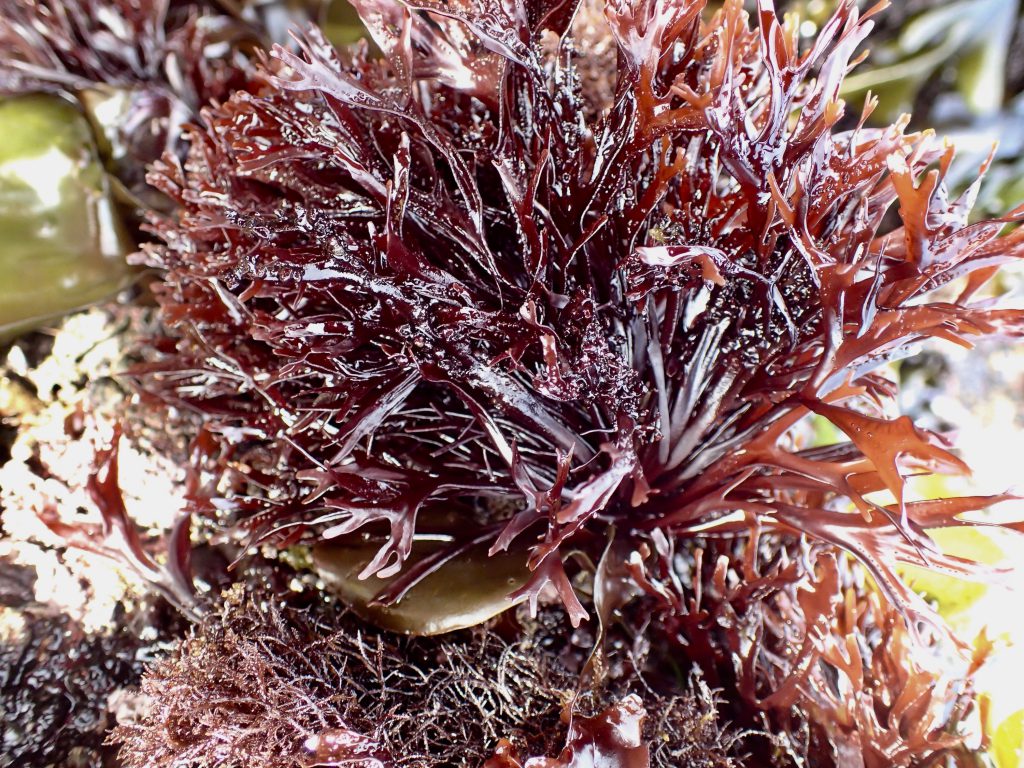
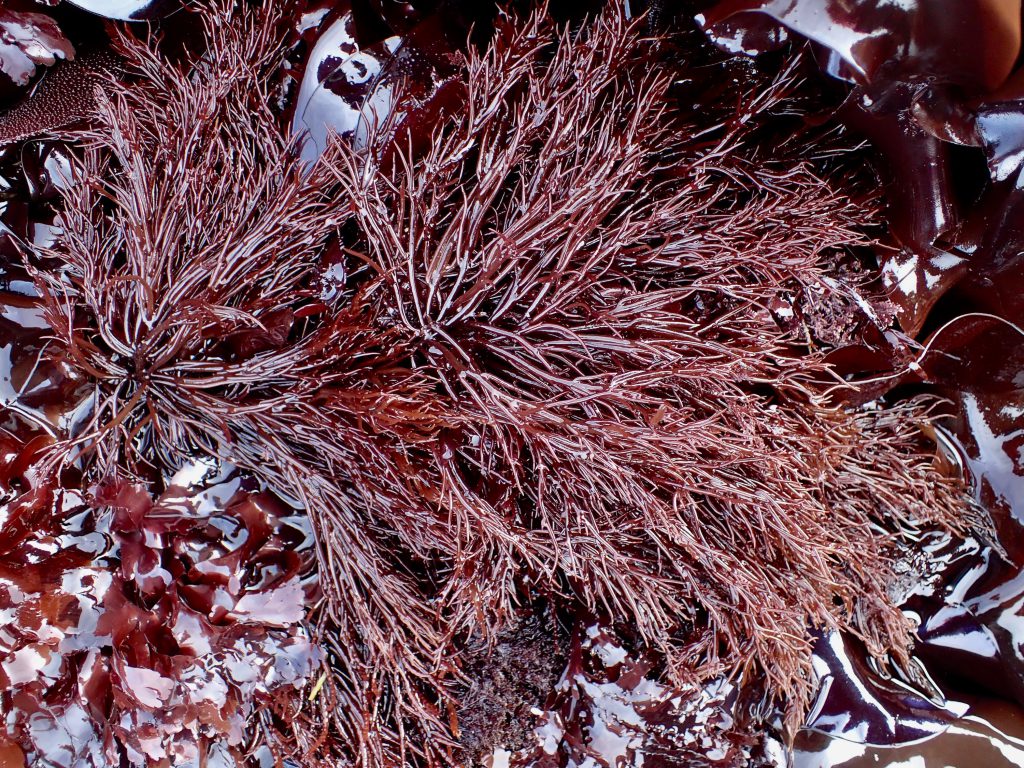
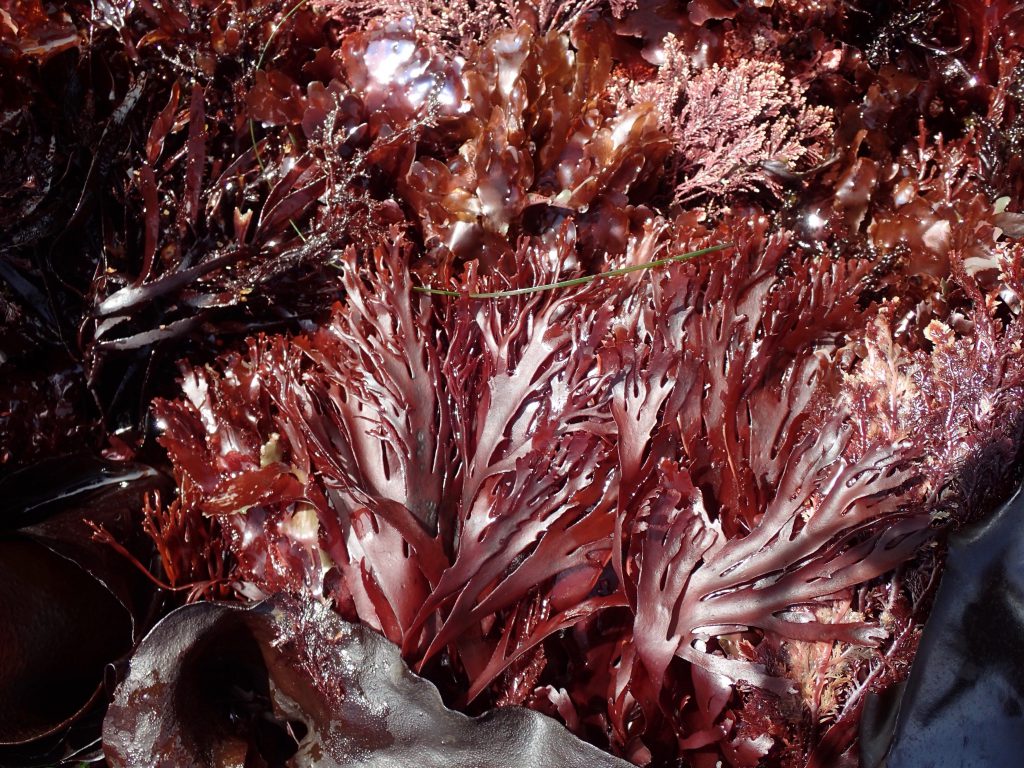
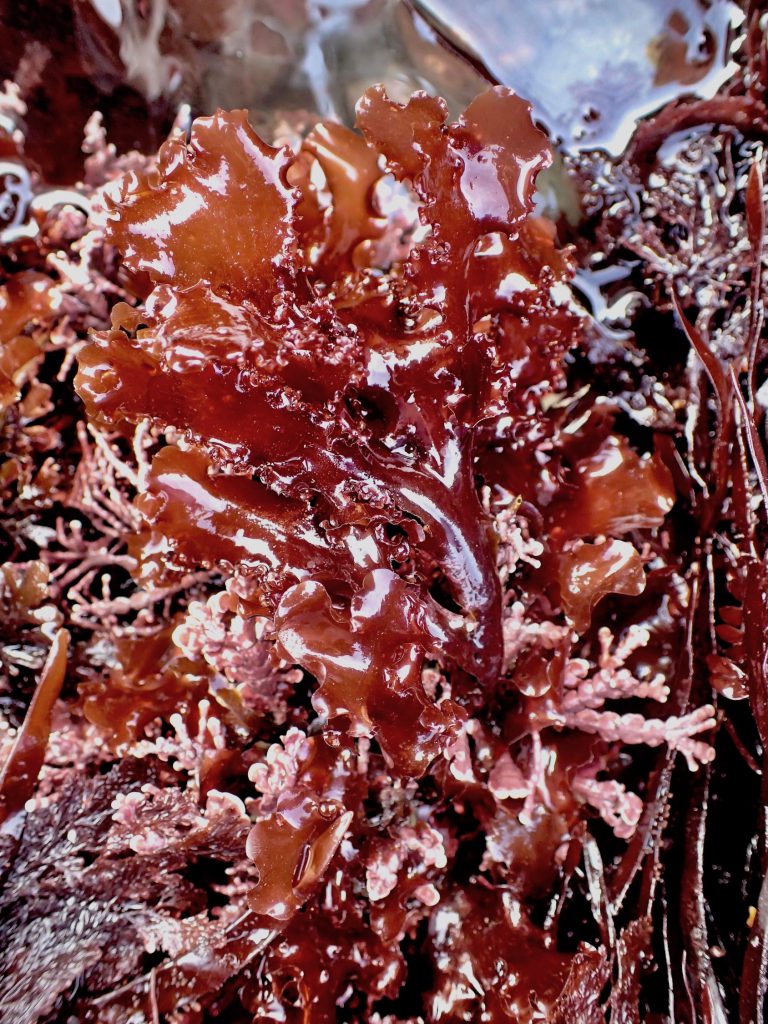
Some of the red algae are epiphytic, living on other algae or plants. Epiphytes are not parasitic and obtain their nutrients from the surrounding water. Although they do not drain nutrients from the alga or plant on which they live, epiphytic algae can occur so densely that they shade their host and deprive it of sunlight. In the intertidal, algae in the genus Microcladia grow as epiphytes. I’ve seen them most often on other reds, but they’ll also live on some of the browns. A while back I wrote about how Microcladia closely resembles another red alga, Plocamium, and how one of the ways to tell them apart is to examine the habitat of each. Microcladia is an epiphyte, and Plocamium grows attached to rocks.
This is Microcladia:
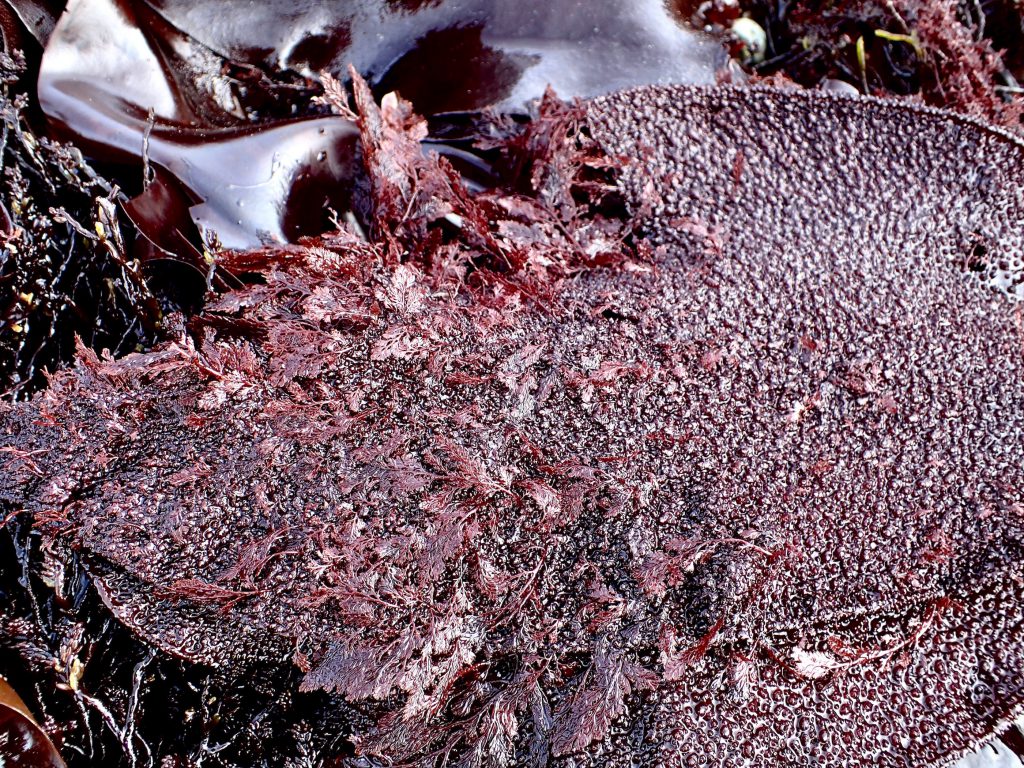
07 June 2019
© Allison J. Gong
You can see the morphology of M. coulteri a little better here, where it is an epiphyte on host with a smoother texture:
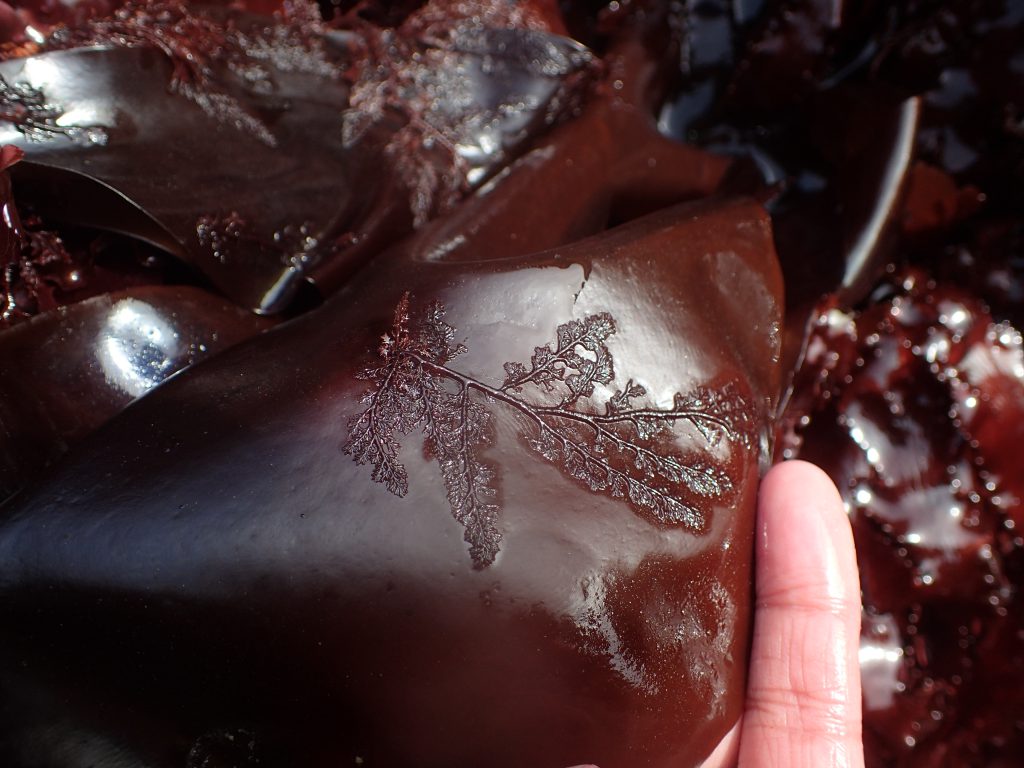
07 June 2019
© Allison J. Gong
The coralline algae are a subset of the red algae. They have a different texture from the other reds, because they deposit calcium carbonate within their cell walls. Corallines can grow as encrusting sheets over surfaces, or have upright branching forms. They are often epizoic (living on animals) or epiphytic.
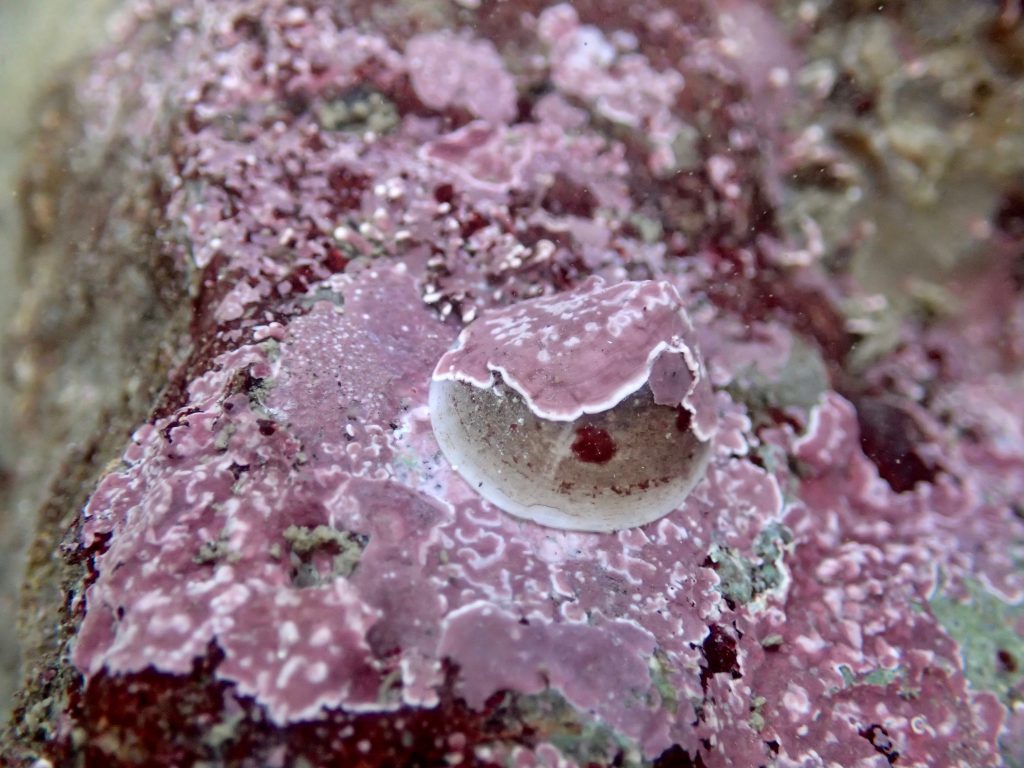
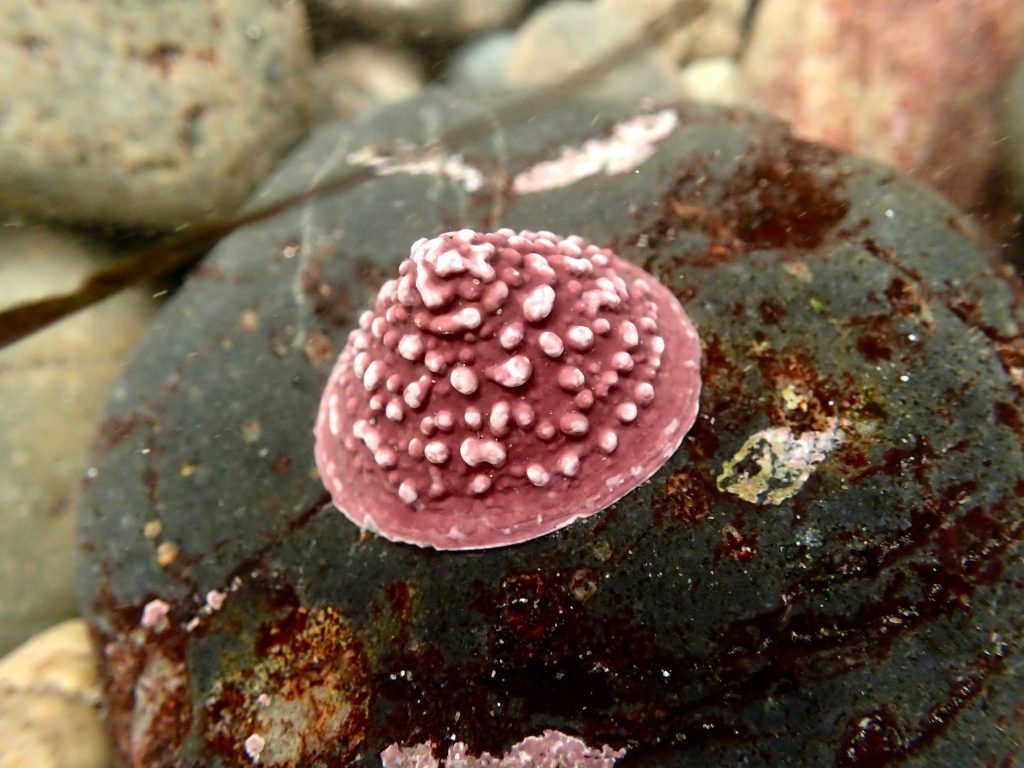
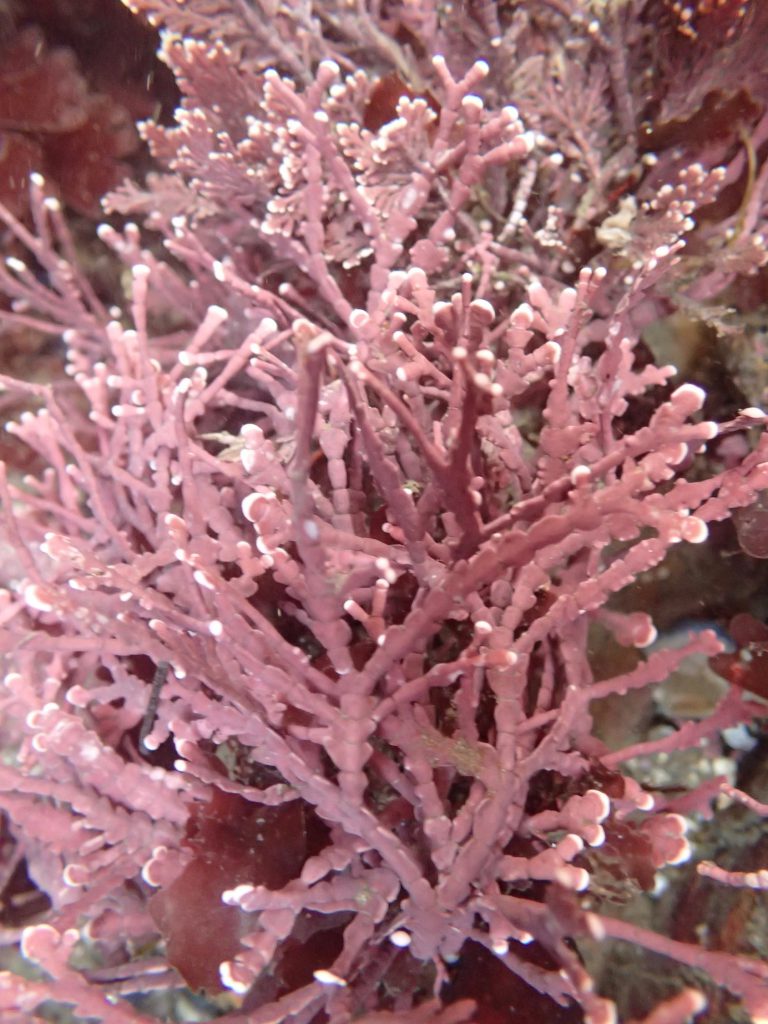
The brown algae
The brown algae (Phylum Ochrophyta) are not as diverse as the reds, but can be locally abundant. The browns come into their own in the subtidal, where they form the physical structure of California’s famous kelp forests. Even in the intertidal they can be among the most conspicuous of the algal flora.
Egregia menziesii, the so-called feather boa kelp, is very common on our coast. It has tough, strap-like stipes that can be 3-4 meters long and a large conical holdfast, so it is pretty conspicuous. Egregia is the most desiccation-tolerant of the kelps around here; it grows as high as the mid-intertidal. The specimen in the photo below looks a little ragged at the ends, which makes me think it might be a holdover from last year.
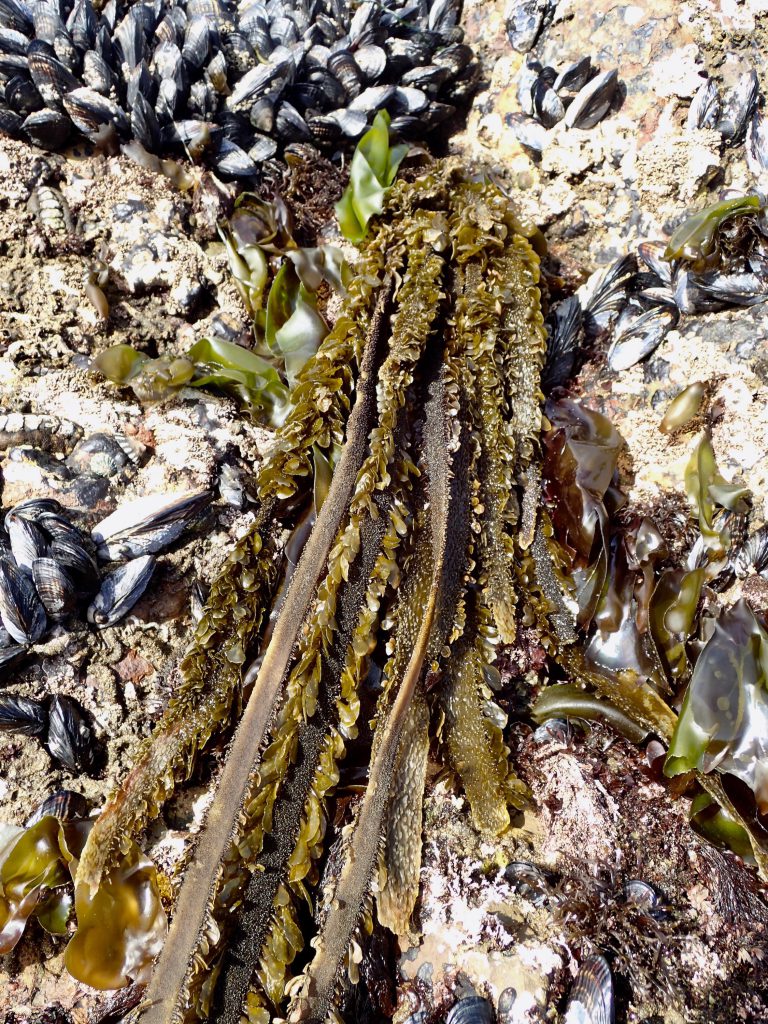
07 June 2019
© Allison J. Gong
I’ve seen Egregia at every rocky intertidal site so far. Other brown algae are more particular about where they live. Dictyoneurum californicum, for example, is a brown alga that lives only in areas that get a lot of water movement. It is seasonally abundant at Pigeon Point, where it is a low intertidal resident, but I don’t see it at more sheltered locations such as Davenport or Natural Bridges. This year D. californicum is at Pigeon Point, although not in large patches as it was a few years ago. As the blades mature, they develop a split in the basal region just distal to the short stipe. The blades themselves feel crunchy and brittle.
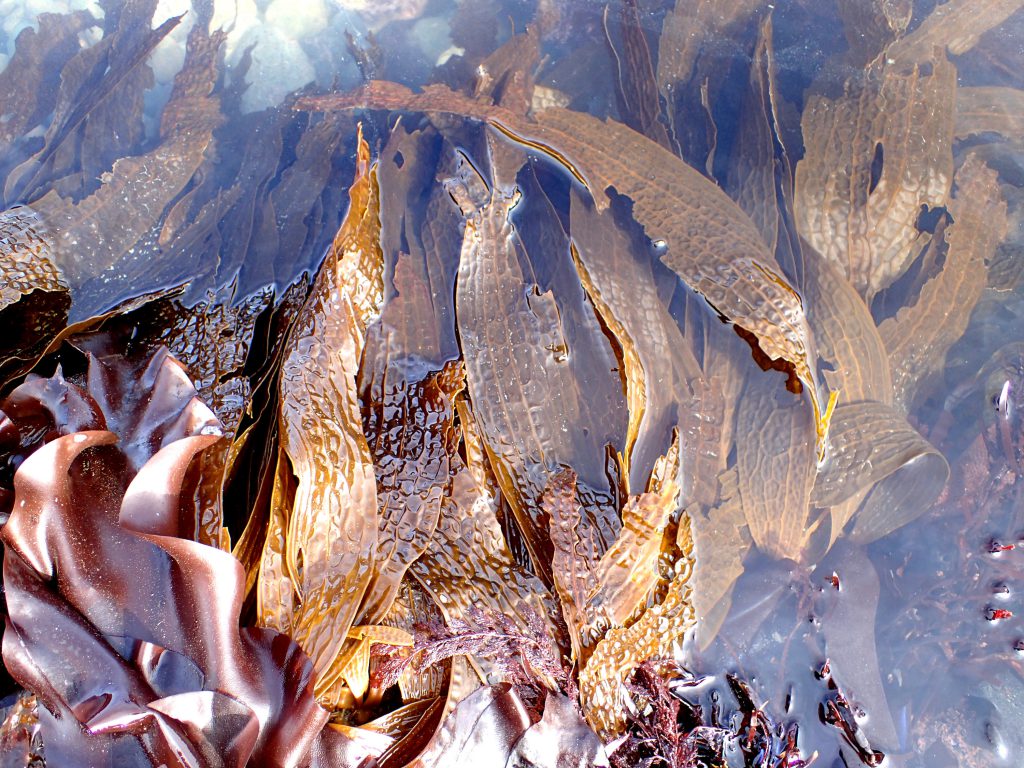
07 June 2019
© Allison J. Gong
All that said, the most remarkable brown alga at Pigeon Point has got to be Postelsia palmaeformis, the sea palm.
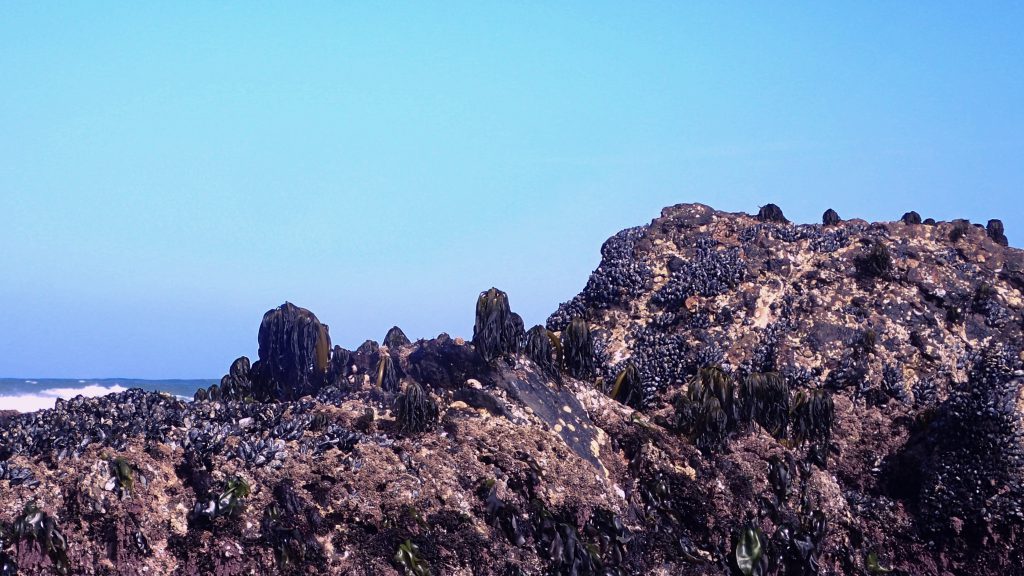
07 June 2019
© Allison J. Gong
Postelsia is restricted to the most exposed rocky outcrops, where they bear the full force of the bashing waves as the tide rises and falls. They stick up defiantly above the surrounding topography, as if daring the waves to do their worst.
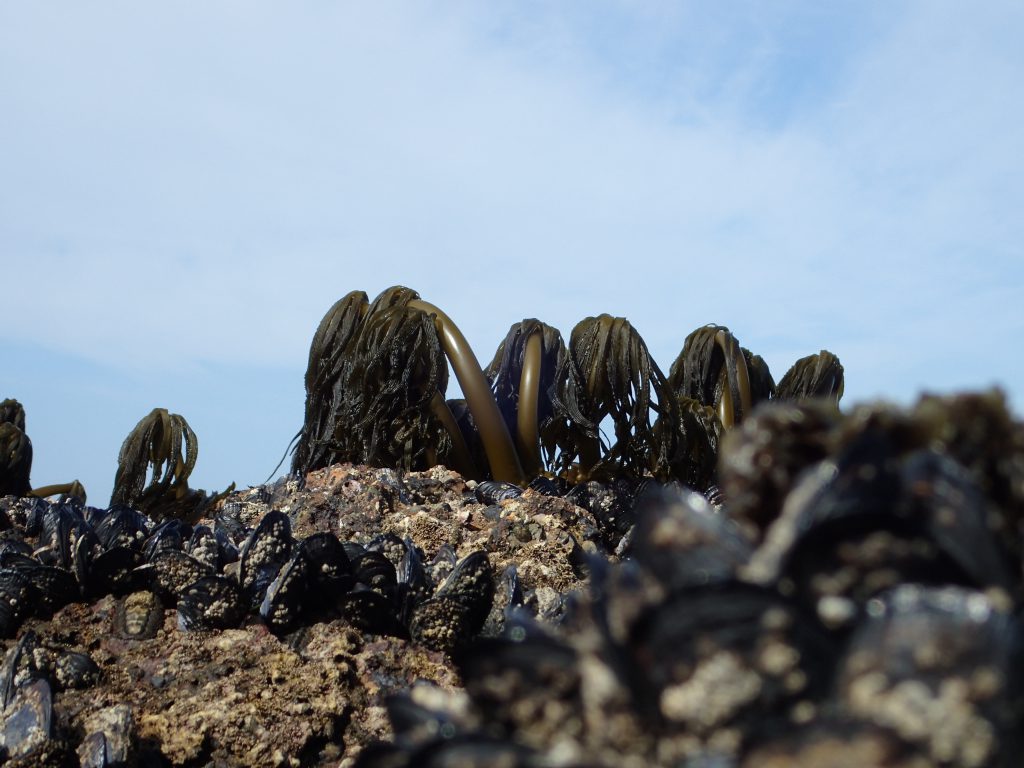
07 June 2019
© Allison J. Gong
Sea palms grow to a height of about half a meter, and are usually the tallest things where they live. They typically occur in small clusters. They do resemble miniature palm trees, don’t they? It’s the thick, very flexible stipe that allows them to live where they do. When the waves come crashing down, the stipe simply bends with the force of the water, and then pops back up after the wave recedes. This hardiness doesn’t make the thalli invincible, though. After winter storms blow through, you can often see Postelsia washed up on the beach.
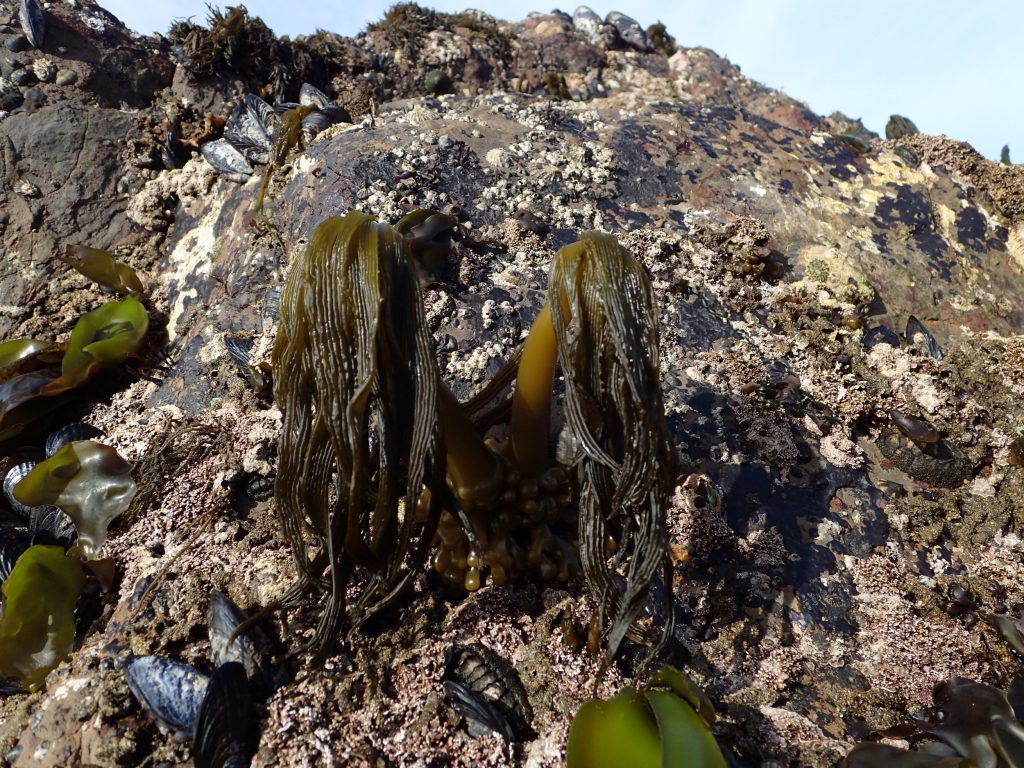
07 June 2019
© Allison J. Gong
You might think that Postelsia gets ripped off rocks by strong waves, but you’d be wrong. The holdfast for these algae is surprisingly tough and good at doing its job. When you see Postelsia stranded on the beach, you’ll usually find that it wasn’t the holdfast that gave way–most likely the rock or mussel it was attached to will have been torn off along with the sea palm. That’s pretty impressive! Of course, any sea palm washed up on the beach is a dead sea palm, so in that sense it doesn’t matter whether it was the alga or the substrate that failed. But given the forces that these algae withstand on a daily basis, it’s remarkable how well they manage to hang on in the high energy environment where they thrive.
Algae don’t get a lot of love, even among marine biologists. If I think there are not many people who study the invertebrates, there are even fewer who study seaweeds. Some organisms have an easier time attracting the attention of human beings, and among macroscopic organisms the invertebrates and algae are probably tied for the bottom ranking. It amazes me that visitors to the seashore can look over a place like Pigeon Point and not see anything. I suppose it’s a matter of getting lost in the forest and forgetting that it is made up of trees, or not even recognizing that it is a forest. In the intertidal the ‘trees’ are at foot level so it does take some work to figure out what’s going on. Like most worthy endeavors, though, the effort is well rewarded.

What I love about your work is that I am learning to see the trees in the forest… I would love to spend a day at the beach with you someday and learn even more! Thank you for being my educator Allison!
I just spent the morning at low tide at the south end of Pescadero Point, learning more of the “trees” from a marine biologist friend who lives in La Honda. Your photos and descriptions of the algae are wonderful and really help the information stick, at least to some degree, in my old brain. Thank you for your wonderful postings. I live in the Pescadero valley, and haunt the intertidal zone often, but without a lot of knowledge of the huge variety of life. Just, really, a great appreciation of its complex beauty.
I’m glad you spent the morning in the intertidal, learning about the algae! And thank you for mentioning that my blog was helpful. I hope you keep enjoying your explorations up in your neck of the woods!